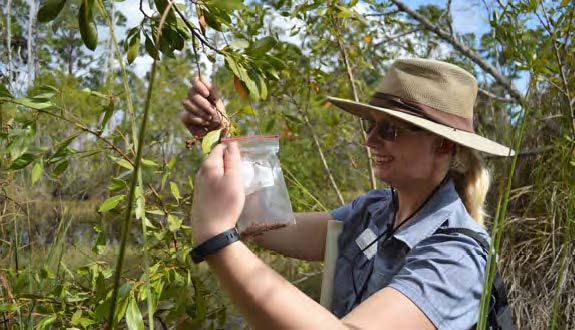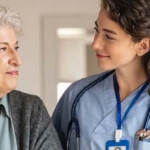Garden Branches Out to Global Issues

by Jeff Lytle
As Naples Botanical Garden grows and prospers, watch for a shift in its messaging and public profile. In addition to keeping its commitment to showcasing natural beauty and public education, the Garden will accent its embrace of global challenges such as climate change and endangered plant species.
Much of the work – the mission – that has been going on for years will be coming more to light.
 The tone is set by the title and content for the latest Garden newsletter, “Conserve.” It features work in our region and beyond – including Haiti, Puerto Rico, Virgin Islands, Dominican Republic and the United Kingdom — to protect and preserve plants and their seeds from threats such as hurricanes, rising seas and development.
The tone is set by the title and content for the latest Garden newsletter, “Conserve.” It features work in our region and beyond – including Haiti, Puerto Rico, Virgin Islands, Dominican Republic and the United Kingdom — to protect and preserve plants and their seeds from threats such as hurricanes, rising seas and development.
“Conserve” articles drill down to applied science such as the benefits of local controlled burns; which vegetation works best for sand dunes in Naples and elsewhere; and studying the wildlife of Rookery Bay. Special attention is directed to a new addition to the Garden on Bayshore Drive, the Evenstad Horticultural Campus, which will include a greenhouse of 22,000 square feet plus much more space for full-sun and shade plants.
The facility will provide Garden horticulture and conservation teams the space and equipment they need to ensure the Garden remains a world-class facility for tropical plants.

Chad Washburn
Chad Washburn, the Garden’s vice president for conservation, explains why the science work is important. “We share a great deal in common with many of the countries of the Caribbean, including facing many of the same threats associated with climate change,” he says. “For us, it makes sense to work across the region to have the greatest impact possible.“
Botanical gardens have become so much more than just a place to visit to see pretty plants. We are a seedbank, a living collection of rare plants, a hub and knowledge base for the community, a place where plants are not only conserved for future generations but also where plants are used to address our most pressing needs.
We use plants and the ecosystems they create to ensure that we have clean water, habitat for wildlife, resilient beaches, forests, mangroves and ecosystems, and so much more.
“We have a mission to save and protect the world’s plants and take that role very seriously.”
In fact, the Garden itself is a restoration project, with its 170 acres reclaimed from invasive plants and neglect.
Washburn says teamwork with other organizations will be emphasized. “The growing changes that we see in our environment due to climate change — including sea-level rise, rising temperatures, increasing frequency and intensity of tropical storm events, increasing invasive plant and pest infestations, and so much more — cannot be faced by any one organization,” he explains.

Andrea Nickrent
Andrea Nickrent, Garden vice president of development and marketing, says the science work fits nicely with another important mission – fundraising. “We recently received a substantial federal grant through the Institute of Museum and Library Services (IMLS) in support of our conservation efforts,” she reports. “Garden staff will document, preserve and share our growing collection of endemic and rare tropical and subtropical plant species. We will also expand our seed bank and seed processing capacity.”
Nickrent goes on: “Botanical gardens and arboreta are racing to conserve plants for the future. Our audiences understand that. By refining our communication and publication strategies, we’re reaching more potential donors than ever and explaining to them in simple terms what we’re doing and why it matters.
“Donors are responding. In fact, a philanthropic couple matched the IMLS grant, and then offered additional funds on top of that amount because they believe in the Garden’s environmentally focused mission and vision.”
Against that background, Nickrent assures the Garden is looking ahead in other directions as well.
“We are in the process of selecting a master planning firm right now. We issued a national request for proposals and received several great submissions from firms around the country. “The Garden has almost as many acres set aside for future development as we do for our cultivated garden spaces. We anticipate 250,000 visitors this fiscal year and we think that will continue to grow in the future.”

Donna McGinnis
Garden President and CEO Donna McGinnis summarizes the changing landscape. “The next time you visit a botanical garden or arboretum, recognize that you’re not just enjoying a beautiful horticultural display — you’ve entered a special community that’s on a mission to save and protect the world’s plants,” she says. “I wish botanical gardens had the power of halting the world’s environmental degradation. But we are striving to mitigate it.
“Through these actions, we hope we can infuse some optimism into an otherwise bleak conversation.”
Garden mission statement: To develop and conserve collections and habitats representative of the flora and cultures between the 26th north and south latitudes. To discover, research and share knowledge about these plants and their gifts to us of beauty, tranquility, sustenance, and well-being. And to engage and inspire everyone to care for the plants around them and become stewards of the environment.




Leave a Reply
Want to join the discussion?Feel free to contribute!